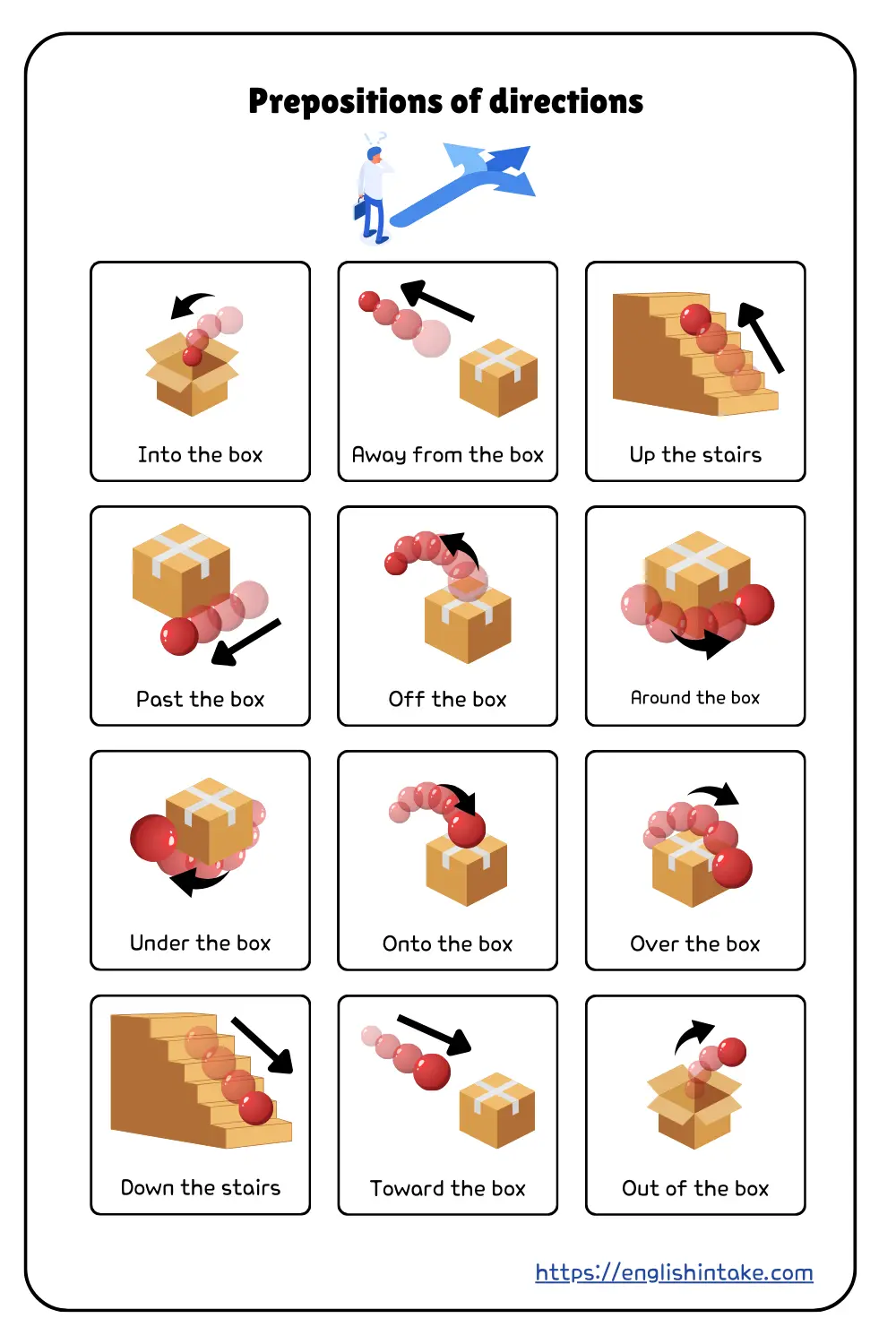1. What are prepositions of direction?
Prepositions of direction are words used to indicate movement from one place to another. They usually appear after verbs of motion like go, run, walk, drive, jump, move, or travel.
Unlike prepositions of place, which describe where something is located, prepositions of movement focus on where something is going. They are particularly useful in everyday situations such as giving direction, describing physical actions, or providing instructions.
- She walked into the room.
- They drove through the tunnel.
- The child climbed onto the table.

2. List of common prepositions of direction with example sentences
toindicates a direction toward a specific destination
I am going to the doctor tomorrow.
intoentering from the outside to the inside
Can you jump into the river from here?
ontogoing to a position on a surface
This cat jumped onto my bed while I was sleeping yesterday.
out ofexiting from the inside to the outside
While I was driving, a cat came out of nowhere and crossed the road. I panicked and bumped into another car. There was smoke coming out of the engine so we had to get out of the car as quick as possible.
offleaving or falling from a surface
My son fell off the table yesterday and broke his ankle.
acrosspassing from one side to the other
You have to walk across the bridge to get into the city centre.
throughgoing in and then out of a space
The rescue team had to go through a dense forest to save the stranded hikers.
towardsheading in the direction of something
The thief looked around and saw nobody. He then walked towards the door to break it.
alongfollowing the edge or course of something
I saw a beautiful girl walking along the river yesterday.
overpassing above something
I hate to see drones flying over my house.
aroundcircling or surrounding something
Pope John Paul II travelled around the world to promote peace.
pastgoing beyond or in front of something
Do we need a visa to drive past the Swiss border?
upheading to a higher place or level
My grandmother can still walk up the stairs without any help.
downheading to a lower place or level
When we were kids, my brothers and I would slid down that hill on cardboard for fun.
3. Common confusions
3.1 In vs into
In shows the position of something that is already inside a space. Into indicates movement from the outside to the inside. If there is movement or a change of place, into is the correct option. If there is no movement and the subject is already within a space or container, in is the right choice.
- The book is in the bag. (The book is already inside the bag.)
- She put the book into the bag. (There is a movement from the outside to the inside.)
3.2 On vs onto
On refers to a fixed position. It describes something located on a surface or along a path. Onto expresses a change in position or direction. Study the example below.
Sarah is arranging her living room. She notices some magazines lying on the floor. She picks them up and places them onto the coffee table. Now, the magazines are on the table. Earlier, the action involved movement. Once the magazines are placed, their position is static, so they are on the table.
- The glass is on the table. (Position)
- The bikes were loaded onto the trailer. (Action + movement)
3.3 To vs towards
To indicates movement with a clear destination. In contrast, toward simply shows the direction of movement without confirming whether the destination has been reached or not. Below is a text illustrating the use of both prepositions.
James left his house early in the morning. Somebody saw him walk toward the train station. At that point, we only know the direction he’s heading. We do not know where exactly he is going. Later, his friend saw him walk to the station entrance. In this case, to confirms that he reached a specific destination. Let’s look at more examples.
- He’s going to the market. (May be he is going to buy something at the market.)
- I’m walking towards the market. (He is moving in that direction, not necessarily going there.)
I hope you have enjoyed this lesson. Check this prepositions of direction worksheet to test your understanding.
